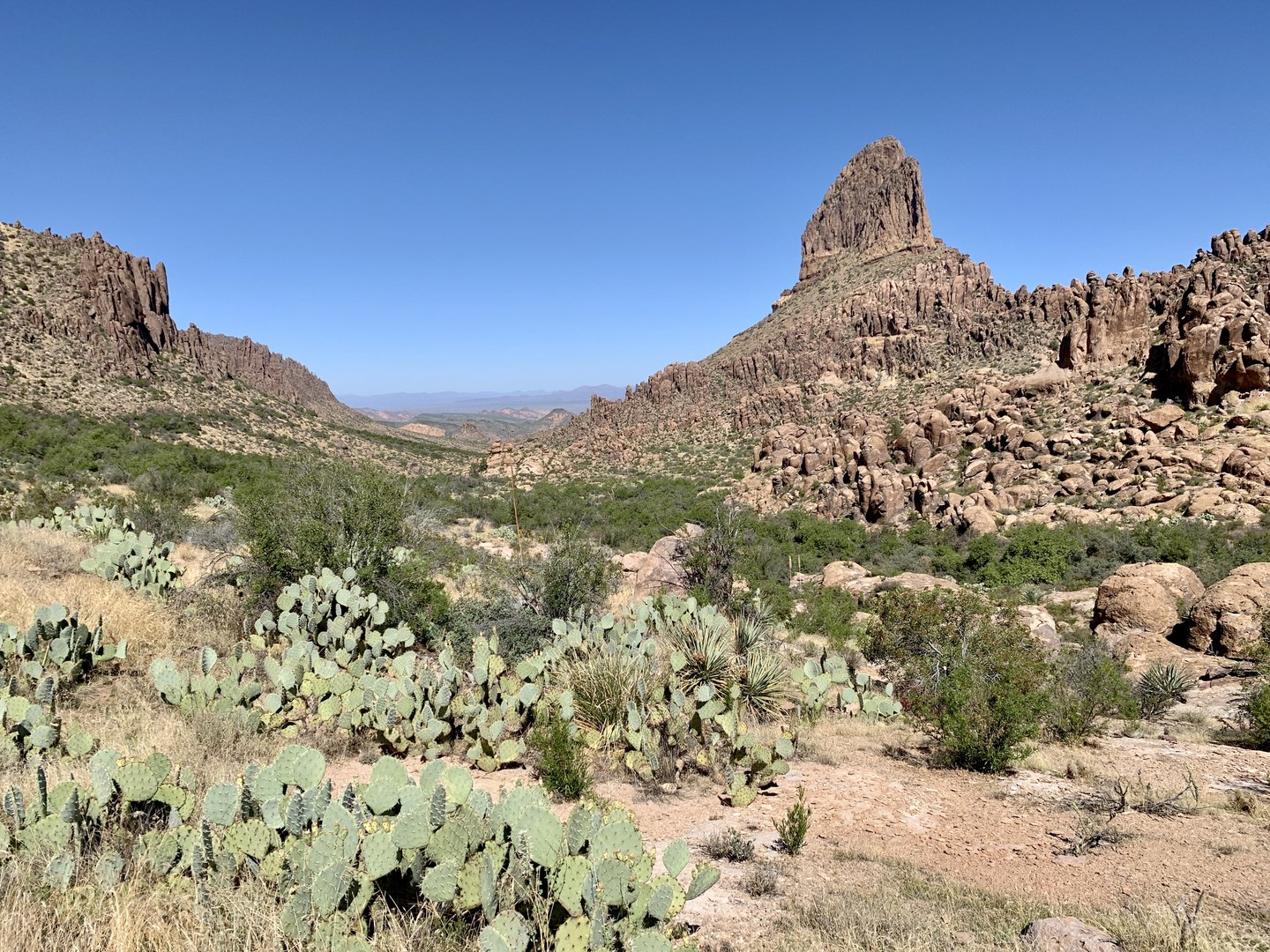You are here
Warning: The Sawtooth Fire in summer 2020 burned the north side of Fremont Saddle, including all around Weavers Needle. All trails are now open as of fall 2020, but the condition of off-trail terrain required to reach the climbing route is unknown at time of writing.
Weavers Needle is an iconic Arizona summit, as the most striking peak among a wonderland of rock pinnacles in the Superstition Wilderness east of Phoenix. It can be seen from miles around, and the view from Fremont Saddle along Peralta Trail is one of the most popular hikes in the area. The Needle is a classic climb of the region, even though technical climbing is a very small portion of it. It's a worthy summit because of the formation's prestige, the view from the top, and the fun of a day out on desert rock. It also makes a good introduction for newbies to adventure climbing.
What's required is about 8 miles round-trip hiking, some off-trail navigation, roughly 4 pitches of 4th and easy 5th-class trad climbing, and a few rappels. Weavers Needle looks like a singular, sheer formation from Fremont Saddle, but it actually has two distinct summits split by a pronounced saddle. The route follows a gully between them in the west face. After the gully tops out, it ascends ledges and obvious weaknesses to the top of the taller north summit.
Begin from Peralta Trailhead and hike over Fremont Saddle. From there, you'll be hiking through the burn area of the 2020 Sawtooth Fire. After going about 1.5 miles beyond the saddle, when you are directly beneath the gully in the west face, look for a cairned climbers' trail on the right. There is more than one way to go, so don't worry too much about finding exactly the right path. Drop into the wash then look for more cairns leading up the slope toward the Needle. This is where routefinding is required, because the climbers' trails are not always obvious and a web of possible routes exists. Look carefully for previously traveled paths and try to stay on them, both for safety and to reduce further erosion.
Eventually you'll reach the bottom of the gully and the climbing begins. The route can be pitched out in a variety of ways, so you'll have to determine what is best for your party. The first 75 feet or so of the gully is easy scrambling. It steepens where an old metal rod protrudes from the wall next to a newer chain anchor. This is marks the first technical pitch, and is where most parties choose to rope up. Gear placements are not ideal or easy to find, but the climbing is straightforward. A leader confident on 5.7 or above should have no problems, despite the tricky gear. At the top of this around-100-foot pitch is a large chockstone and the crux of the climb. The few moves right below the chockstone are probably the steepest of the whole route, and you must decide the best way to get around the chock. The easiest way is to crawl under it through a tunnel, but it can also be bypassed to the left or right.
Above the chockstone, build an anchor or find the nearby chains to belay (rope drag can be tricky to negotiate). From there, a short 5th class section leads to much easier ledge scrambling toward the north summit. Most parties unrope for this part. Find the path of least resistance up irregular gullies, ledges, and boulders, and sometimes through vegetation. Eventually you'll come to a larger, open ledge on the southwest side of the formation. From there the climb continues up a more west-facing aspect to the top. This final pitch is easy 5th class, but is rather exposed over the west face, so you will probably want to rope up once more.
On top, you'll enjoy 360-degrees of vantage over the Superstition Wilderness. You can see Peralta Canyon and most of the terrain you just hiked. Four Peaks, the Salt River Canyon, and Canyon Lake are visible to the north. You can also see some of the Phoenix Mountains and part of the city in the distance. There are two decent bivy spots up here, and it can be fun to spend the night on top if you want to haul all the supplies.
To descend, find the chain anchors to climbers' right of the where the final pitch tops out, then rappel to the bottom of this pitch. Downclimb the ledges to the top of the chockstone pitch, then use a chain anchor to rappel again. You can use the chain anchor at the bottom of this pitch for a final rappel, or simply downclimb the remainder of the gully. A single 70-meter rope is sufficient for each of the rappels.
The climb is usually done in the cool months, late fall through early spring. Winter nights can get quite cold at this elevation, but days are usually sunny and warm. There's no reliable water anywhere along the trail or the climb, so bring lots.
Logistics + Planning
Current Weather: Powered by Dark Sky






























Comments
Sign In and share them.